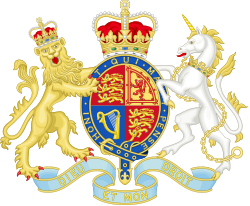Richard Webster, 1. Viscount Alverstone

Richard Everard Webster, 1. Viscount Alverstone GCMG QC (* 22. Dezember 1842 in London; † 15. Dezember 1915 in Cranleigh) war ein britischer Jurist und Politiker.[1]
Leben
Webster war der zweite Sohn von Thomas Webster. Er besuchte die King’s College School, die Charterhouse School und das Trinity College (Cambridge).
In seinen frühen Jahren war er als ausgezeichneter Athlet bekannt. Er behielt auch später sein Interesse an Cricket und Laufsportarten. Von 1895 bis zu seinem Tod war er Präsident des Surrey County Cricket Clubs sowie im Jahre 1903 des Marylebone Cricket Clubs.
Nachdem Webster 1868 Barrister geworden war, wurde er bereits 10 Jahre später Kronanwalt. Im Juni 1885 folgte seine Berufung zum Attorney General. Einen Monat später wurde er ins House of Commons gewählt. In den folgenden Jahren vertrat er mehrfach die britischen Interessen in Schiedskommissionen, die internationale Grenzkonflikte schlichteten. Das Amt des Attorney Generals behielt er bis ins Jahr 1900.
Im Jahre 1900 folgte er Sir Nathaniel Lindley in das Amt des Master of the Rolls nach. Am 18. Juni 1900 wurde er mit dem Titel Baron Alverstone, of Alverstone in the County of Southampton, in den erblichen Adelsstand erhoben. Im Oktober desselben Jahres wurde er zum Lord Chief Justice of England berufen. Er folgte dem im Amt verstorbenen Lord Russell of Killowen. Webster ging 1913 in den Ruhestand und erhielt am 24. November 1913 den weiteren Adelstitel Viscount Alverstone, of Alverstone in the County of Southampton.
Er starb in Cranleigh, Surrey und wurde auf dem West Norwood Cemetery begraben. Mit seinem Tod erloschen seine Adelstitel, da er keine männlichen Abkömmlinge hatte.
Weblinks
- Richard Everard Webster, 1st Baron Alverstone auf thepeerage.com, abgerufen am 20. August 2015.
- Sir Richard Webster im Hansard (englisch)
Fußnoten
- ↑ Webster, Richard Everard. In: John Archibald Venn (Hrsg.): Alumni Cantabrigienses. A Biographical List of All Known Students, Graduates and Holders of Office at the University of Cambridge, from the Earliest Times to 1900. Teil 2: From 1752 to 1900, Band 6: Square–Zupitza. Cambridge University Press, Cambridge 1954, S. 391 (venn.lib.cam.ac.uk Textarchiv – Internet Archive).
| Personendaten | |
|---|---|
| NAME | Webster, Richard, 1. Viscount Alverstone |
| ALTERNATIVNAMEN | Webster, Richard Everard, 1. Baron Alverstone; Webster, Richard |
| KURZBESCHREIBUNG | englischer Anwalt, Politiker, Mitglied des House of Commons und Richter |
| GEBURTSDATUM | 22. Dezember 1842 |
| GEBURTSORT | London |
| STERBEDATUM | 15. Dezember 1915 |
| STERBEORT | Cranleigh, Surrey |
Auf dieser Seite verwendete Medien
Autor/Urheber: Sodacan, Lizenz: CC BY-SA 3.0
Royal Coat of Arms of the United Kingdom of Great Britain and Northern Ireland in the style used by the Government of Queen Elizabeth II from 1952 to 2022 (as used in all places except Scotland).
| “ | Quarterly, First and Fourth Gules three lions passant guardant in pale Or armed and langued Azure (for England), Second quarter Or a lion rampant within a double tressure flory counter-flory Gules (for Scotland), Third quarter Azure a harp Or stringed Argent (for Ireland), the whole surrounded by the Garter; for a Crest, the imperial crown Proper; for Supporters, dexter a lion rampant guardant Or crowned as the Crest, sinister a unicorn Argent armed, crined and unguled Proper, gorged with a coronet Or composed of crosses patée and fleurs de lys a chain affixed thereto passing between the forelegs and reflexed over the back also Or; Motto 'Dieu et mon Droit’ ('God and my Right') below the shield. | ” |
- PINCHES, J.H & R.V., The Royal Heraldry of England, 1974, Heraldry Today.
Richard Webster, 1st Viscount Alverstone
Autor/Urheber: Sodacan, Lizenz: CC BY-SA 3.0
Royal Coat of Arms of the United Kingdom of Great Britain and Northern Ireland in the style used by the Government of Queen Elizabeth II from 1952 to 2022 (as used in all places except Scotland).
| “ | Quarterly, First and Fourth Gules three lions passant guardant in pale Or armed and langued Azure (for England), Second quarter Or a lion rampant within a double tressure flory counter-flory Gules (for Scotland), Third quarter Azure a harp Or stringed Argent (for Ireland), the whole surrounded by the Garter; for a Crest, the imperial crown Proper; for Supporters, dexter a lion rampant guardant Or crowned as the Crest, sinister a unicorn Argent armed, crined and unguled Proper, gorged with a coronet Or composed of crosses patée and fleurs de lys a chain affixed thereto passing between the forelegs and reflexed over the back also Or; Motto 'Dieu et mon Droit’ ('God and my Right') below the shield. | ” |
- PINCHES, J.H & R.V., The Royal Heraldry of England, 1974, Heraldry Today.


